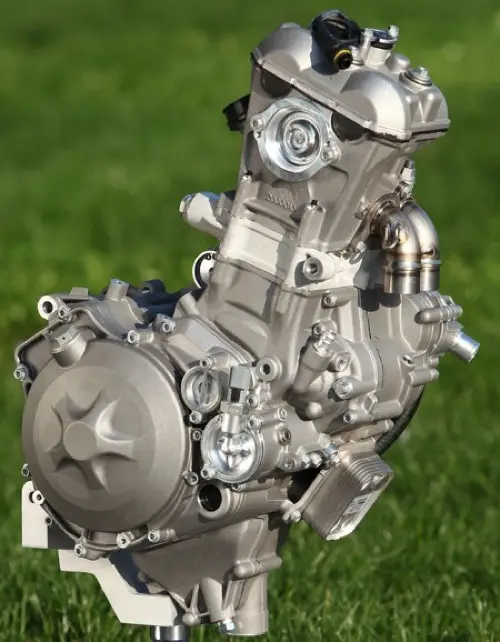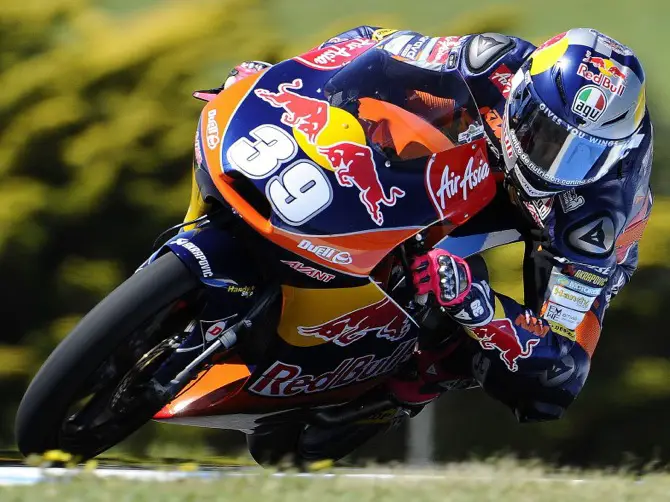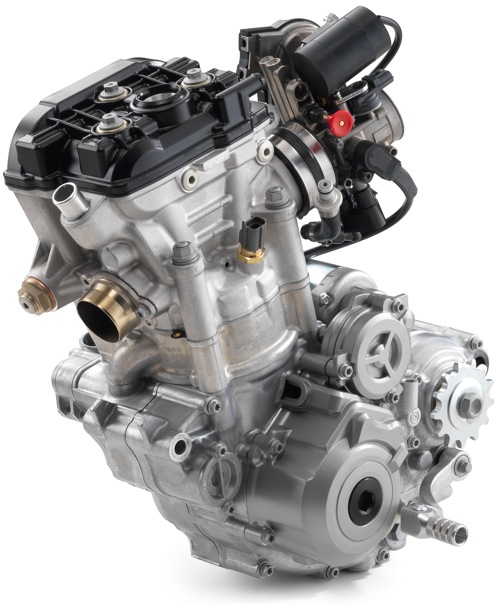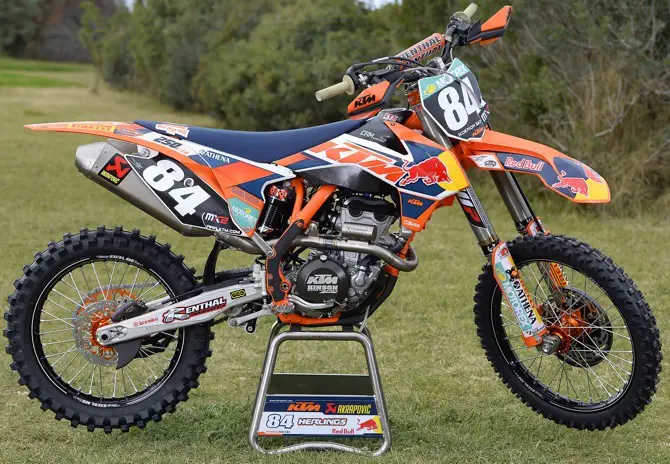MOTO3 ROAD RACER VERSUS 250SXF MOTOCROSSER
The arrival of Moto3 brought with it the end of two-stroke Grand Prix racing. Cutting through the smoke came a new 250cc class that adopted an engine configuration exactly the same a 250cc motocross machine. Arguably the the fastest 250 motocross engine, KTM has also proved itself on asphalt in its two seasons of Moto3.
When the FIM laid out its rules for Moto3, it banned the use motocross engines as a foundation. Despite the rule, KTM’s successful Moto3 story began with a dirt bike. KTM Factory engineers adapted one of the 350cc single-cylinder engines and stuffed it into one of their 125 GP road race chassis as a test mule.
INSIDE THE KTM MOTO3 ENGINE WITH KURT TRIEB

“The Moto3 and MX2 engines produced from KTM are worlds apart,” says Kurt Trieb, the man tasked with engine construction for KTM’s Moto3 engine – originally dubbed M32 (Moto3 2012) – in the Munderfling-based factory race workshops in Austria. Trieb explains the 350cc test mule built back in 2010: “The test with the 350cc was for a lot of different things – such as fuel consumption, power characteristics, weight – and we learned a lot. But the riders complained about vibrations. They said they wouldn’t be able to finish a race on a bike with this much vibration!”
It was clear pretty quickly that the Moto3 engine would have to be a completely new design and with a new chassis surrounding it. “The main point is that the engine has to fit into the bike concept – the package, comprising mainly of the chassis of course. That may sound simple, but there’s a lot to take into account,” Trieb adds.
As you can see from the photos, the Moto3 engine is quite a bit taller than that the KTM 250 SXF engine. In motocross, maximum ground clearance is needed for jumps – MotoGP doesn’t tackle big jumps, ruts or berms.
Trieb said, “The main difference between two engines is that there is a deep and steep inlet port in the Moto3 engine. The KTM RC250 GP has its airbox behind the head tube, which helps the engine get more air to increase top-end power output. The center of gravity has been very important in this package, but also important was the position of fuel tank, which is a vertical shape directly behind the inlet port. This combined with the clutch being quite low makes the engine looks very tall, but when you see it in the bike it fits very well.”
DIFFERENT STROKES FOR DIFFERENT SPORTS
Moto3 and MX2 riders use their engines very differently. According to KTM, a Moto3 engine is always used between 9000 rpm and 14,000 rpm – the maximum permitted revs for the class – and a Moto3 rider will also be using maximum power for about 70% of that time. In motocross, there’s hardly any chance in a lap for a rider to get the throttle wide open for that length of time.

This difference in style leads to very different requirements from the engine, most of all reliability with such long durations of high revs. Kurt Trieb explains how they managed that in the Moto3 engine: “On road race engine we had to design a different lubrication system. More oil is needed (Moto3 carries 0.8 liter compared with MX2’s 0.3 liter) and a deep sump with an additional oil/water heat exchanger accommodates this. The gearbox and the clutch are arriving outside the engine oil, so that, again, is why the engine looks taller compared with the MX2 engine when it’s out of the bike.”
Due to motocross packaging reasons, the airbox on a motocross bike is under the seat and the fuel tank is in front, which decides the appearance of the inlet ports. So an engine will take its looks not only because of performance, but to fit its intended package.The reason for such a large and forward airbox on the road race bike is because Moto3 is always on full load and needs a lot of air rushing through, where as motocross is more rolling on snd off with the throttle due to constant cornering.

POWER OUTPUT
The M32 engine in 2012 made 54 horsepower and the championship-winning 250 SXF made 46 horsepower. Part of the FIM’s technical requirements for the road race class ‘restricts’ all bikes to a rev ceiling of 14,000 rpm and this is controlled with a spec ECU (engine control unit or brain), while MX2 has no such limitations and the 250 SXF factory bike will rev to 15,000 rpm. As the Moto3 bike is ‘restricted’ by how fast the single piston can travel, a larger bore over its dirt relation is utilized.

Throughout the first Moto3 season in 2012, the KTM engine became known for having very good top end power. Offering the riders a wider spread of power had been an issue for the engineers from the beginning.Trieb adds: “To provide a broader powerband we were thinking about a smaller bore, but now we have managed to create a quite a good powerband even with the big bore of the engine.The capacities are the same and dimensions are not so dramatically different. The RC250R’s bore-and-stroke is 81mm x 48.5mm compared with the 250SXF’s 78mm x 52.3mm—both have a similar piston weight.”
“Another big difference,” Trieb says, “Is that the road race crank drive has full plain bearings – no roller bearings for the mains – and has a full countershaft for mass balancing. This has been a request of the riders to reduce vibrations as much as possible; a big effort was made to dramatically reduce this.There are also very common engine design philosophies that are shared, liked the vertical spilt crankcase, separate cylinder, finger followers for the valve train and piston and conrod design.”
INSIDE THE KTM 250SXF MOTOCROSS ENGINE WITH FLORIAN EBNER
Florian Ebner, Technical Manager of KTM Racing OffRoad said, “We’re very much focused on rideability of the whole bike and as everyone knows that on an offroad bike it depends on suspension. So many things are about suspension and the influence the engine has on this – from power to engine position. It has such an influence. Rideability is sometimes way more important than peak power.

“The 250 SXF is a very compact engine. What it is definitely obvious is that, compared to Moto3, we need a lot of ground clearance. So it needs to be more compact vertically. We try to centralize the mass in the bike and that’s much easier with compact engine that is close to the swingarm bolts and close to center of gravity.
“So the vertical size is very small and the engine is cut directly under the crankshaft. The case stops very close to the crank, but with a bit of volume for the oil, but not too far down. Partly for ground clearance and because the gearbox and clutch are partly in oil. The way an motocross rider uses the clutch is very different to a road racer. Motocrossers will use it around 50 times a lap in a race; using it for shifting and to modify the engine character. So for this reason we put the clutch in the sump and though we know we lose a bit of power by doing this, it benefits with rideability.”
“The factory motocross team riders will race with an engine that will become the following season’s production bike engine. This has always been the way and means that the bike you can buy from the showroom is already on a very good level. Just look at any local motocross race to see how many orange bikes there are.”
“Our factory race bike is based on a stock 250 engine which is at a high level already. Engine wise, we start working on details to raise the performance or adopt it to the riders needs. These detail changes will alter the riding characteristics.Like all tuning, we will add components made of more expensive material with higher strength and with closer tolerances—then raise this with standard tuning processes. Of course we test with the factory riders to see which direction we go with the engine character.The power delivery or character can be adapted with electronic fuel injection mapping, cam timing with camshafts and valve timing. A lot of small parameters can still let us adopt the engine to make it easier for the riders, such as clutch actuation.”
For more info go to blog.ktm.com/moto3-vs-mx2-just-dirt-bike-engines-in-a-grand-prix-chassis/
Photos: Gold & Goose, S. Taglioni, Ray Archer & KTM









Comments are closed.